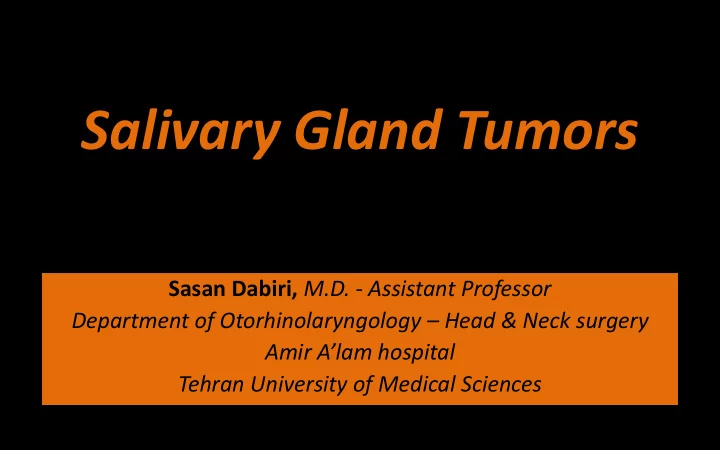

Salivary Gland Tumors Sasan Dabiri, M.D. - Assistant Professor Department of Otorhinolaryngology – Head & Neck surgery Amir A’lam hospital Tehran University of Medical Sciences
Salivary Gland Tumors Epidemiology • Overall prevalence: – 3% of Head & Neck neoplasms – 100 parotid neoplasms – 10 submandibular neoplasms – 10 minor salivary gland neoplasms – 1 sublingual neoplasm
Salivary Gland Tumors Epidemiology • The most common neoplasms: – Benign in anywhere: Pleomorphic Adenoma – Malignant in parotid: Mucoepidermoid Carcinoma – Malignant in others: Adenoid Cystic Carcinoma – Post radiation, benign: Warthin’s tumor – Post radiation, malignant: Mucoepidermoid Carcinoma
Salivary Gland Tumors Fine Needle Aspiration / Biopsy • Goals are: – Differentiation of neoplastic and non-neoplastic mass – Differentiation of benign and malignant neoplasm • High specificity (96-98%) • Good sensitivity (79-96%)
Salivary Gland Tumors Fine Needle Aspiration / Biopsy • Is it Accurate? – Highest inaccuracy rates in Parotid • Diversity in pathology ( 11 benign & 24 malignant ) • Other than mixed tumor, are uncommon • Morphologically complex • Some carcinomas have not malignant cellular appearance Lower accuracy for diagnosing malignant tumor
Salivary Gland Tumors Frozen Section • Indications : – Determination of tumor extension – Evaluation of surgical margin – Non-diagnostic FNA – Incompatible FNA according to clinical judgement
Salivary Gland Tumors Imaging
Salivary Gland Tumors Imaging
Salivary Gland Tumors Imaging
Salivary Gland Tumors Imaging
Salivary Gland Tumors Imaging
Salivary Gland Tumors Imaging
Salivary Gland Tumors Imaging • Differentiation of benign and malignant tumors is not the primary goal of CT and MRI; but: – Anatomical localization – Local, Regional (lymph node), and Distant invasion • Overall – Low intensity in T1 & T2 malignant (high probable)
Salivary Gland Tumors Imaging • Why MRI is better than CT? – Well visualized on T1 (especially parotid “fatty gland”) • Excellent assessment of margins • Deep extension & Infiltration – Best mapping on T1+ Gd + Fat suppression • Bone marrow & cortex: hyposignal invasion, well visualized • Fatty & bony foramina at skull base: hyposignal perineural spread: well visualized • Meningeal invasion
Salivary Gland Tumors Imaging • Perineural invasion for parotid tumor – Facial nerve • entire nerve should be assessed all the way ( even if there is no clinical facial paralysis ) – Auriculotemporal nerve • through a small fat pad along the medial aspect of the lateral pterygoid muscle and just inferior to the foramen ovale
Salivary Gland Tumors Imaging • Perineural invasion for submandibular tumor – Hypoglossal nerve • Tongue movement impairment – Lingual nerve • Tongue tingling MRI visualizes : • enlarged nerve • obliterated fat • enlarged ganglion • atrophy of the masticator muscles
Salivary Gland Tumors Imaging • Radionuclide Scanning (Tc 99m) – Warthin’s tumor – Oncocytoma Helpful for elderly patients with parotid mass Aldred Scott Warthin 1866 - 1931
Salivary Gland Tumors Imaging • Ultrasonography Pros – Differentiation of glandular from extraglandular mass – Guiding the biopsy (FNA) Cons – Operator dependent – Just in superficial masses
Salivary Gland Tumors Pleomorphic Adenoma • Epithelial and Mesenchymal components • 10% risk of malignancy after 15 years
Salivary Gland Tumors Warthin’s tumor • Papillary Cystadenoma Lymphomatosum • Only in parotid • Male & cigarette smoking • No risk of malignancy • bilateral
Salivary Gland Tumors Mucoepidermoid Carcinoma • Contains mucoid and epidermoid cells • Low, intermediate and high grade classification
Salivary Gland Tumors Adenoid Cystic Carcinoma • Perineural invasion • Grading according dominant cells: • Cribriform • Tubular • Solid
Salivary Gland Tumors Management • Surgery – primary management in all new and recurrent cases Unless : • Surgery cannot be done ( patient’s condition ) • Invasion to skull base T4b • Invasion to pterygoid plates • Encase carotid artery
Salivary Gland Tumors Management • Radiation therapy ± Chemotherapy – Unable to surgery – Adenoid cystic carcinoma – Intermediate or high grade carcinoma In cases with – Close or positive margin complete resection – Perineural or perivascular invasion – Lymph node metastasis
Thanks for Your Attention
Recommend
More recommend